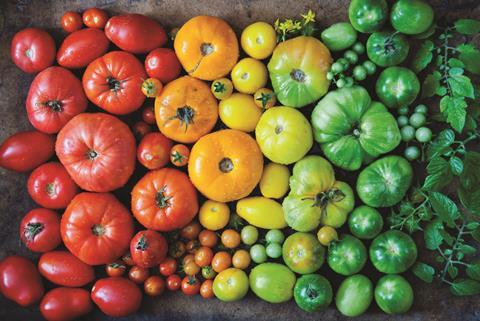Flavoursome tomato varieties could benefit from nanoparticle fertilisers

Tasty heirloom tomato varieties could soon see a return to our plates thanks to the promising antifungal properties of metal oxide nanoparticle fertilisers developed by US scientists.
Centuries of plant breeding mean we’ve grown accustomed to a narrow range of crops bred primarily for their disease resistance. But while we reap the benefits of greater yields and reliability, we’re missing out on a host of different flavours from less disease-hardy varieties.
Now a nanoparticle crop treatment developed by Wade Elmer and Jason White at Connecticut Agricultural Experiment Station, US, could give older tomato varieties – more susceptible to root pathogens such as wilt fungus – a helping hand. Applying copper and manganese oxide nanoparticles to the leaves of tomato plants grown in soil infected with the Verticillium wilt fungus increased fruit yields by up to 33% compared with untreated plants.
Micronutrients such as copper and manganese are vital for a plant’s protection against fungal attack, yet getting these elements to where they’re needed can be tricky. Traditional ionic metal salts applied to the plant’s leaves rarely find their way to the roots. Nanoparticles, however, get taken up by the leaves and are transported to the roots, which means lower treatment levels and less environmental exposure to metals.
While the benefits of nanoparticle fertilisers are clear, some believe safety scrutiny hasn’t kept pace. Om Parkash Dhankher, environmental and agricultural biotechnology scientist at the University of Massachusetts Amherst, US, recommends monitoring safety over longer periods. ‘It’s important to remember that at higher levels these metals are toxic, and repeated use can pose an environmental threat’ says Parkash Dhankher. ‘My view is these types of material are emerging pollutants and may be a future dead-end in terms of food safety’.
How the nanoparticles promote antifungal resistance is also up for debate. Some experts suggest the metal nanoparticles correct a nutritional deficiency in the plant. Others, including Elmer, believe nanomaterial exposure turns on a plant’s defence mechanisms. ‘I’m interested in finding out whether the copper nanoparticles, which we found the most effective, are able to turn on enzyme systems in the root, which help the root produce lignin and phenolic compounds which protect against infection’ he tells Chemistry World.
References
This article is free to access until 10 October 2016
W H Elmer and J C White, Environ. Sci.: Nano, 2016, DOI: 10.1039/C6EN00146G












No comments yet